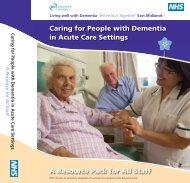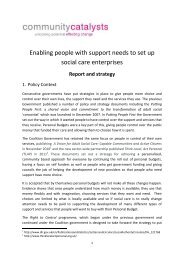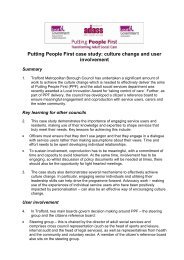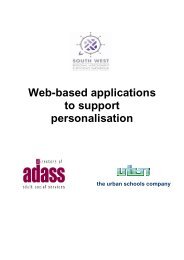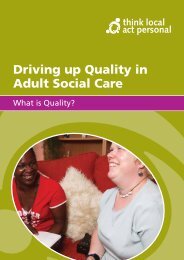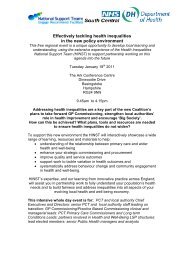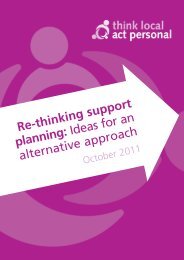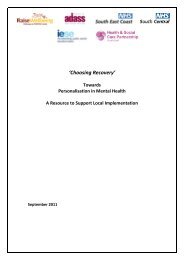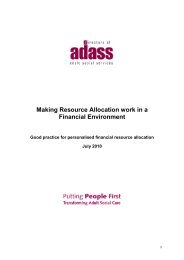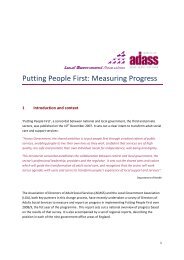Practical approaches to safeguarding and personalisation (pdf ...
Practical approaches to safeguarding and personalisation (pdf ...
Practical approaches to safeguarding and personalisation (pdf ...
Create successful ePaper yourself
Turn your PDF publications into a flip-book with our unique Google optimized e-Paper software.
<strong>Practical</strong> <strong>approaches</strong> <strong>to</strong> <strong>safeguarding</strong> <strong>and</strong> <strong>personalisation</strong><br />
3. Building connections<br />
It is important that people are supported <strong>to</strong> be more connected <strong>and</strong> recognised as active<br />
citizens within their communities. This in turn creates stronger communities, where people<br />
with care <strong>and</strong> support needs are visible, valuable members of the local area. As outlined<br />
above, the process of self-directed support <strong>and</strong> allocating personal budgets should increase<br />
people’s underst<strong>and</strong>ing of risks, options for managing those risks, <strong>and</strong> ways of balancing this<br />
with achieving the outcomes they want.<br />
‘Putting people in control of their own destiny in this way strengthens their skills <strong>and</strong><br />
increases their confidence, facilitating increased connectivity or “circles of support”,<br />
which in turn, increase the likelihood of potentially abusive situations being noticed.<br />
Stronger citizens are less likely <strong>to</strong> become victims of abuse, while stronger communities<br />
are more likely <strong>to</strong> notice the early signs of potential abuse occurring.’ 14<br />
Involving carers, family <strong>and</strong> friends as partners<br />
Personalisation is about designing systems of support that work well for an individual <strong>and</strong>,<br />
where they wish it, their family or circle of support. It recognises the uniqueness of each<br />
person’s lifestyle <strong>and</strong> relationships. Carers, family members <strong>and</strong> friends can bring their<br />
knowledge <strong>and</strong> experience <strong>to</strong> help identify risks <strong>and</strong> strategies for balancing risk <strong>and</strong> choice.<br />
Assessment processes should identify the level of caring that families wish <strong>to</strong> provide <strong>and</strong> any<br />
risks <strong>to</strong> their health <strong>and</strong> well-being of doing so. Support plans should consider how <strong>to</strong> ensure<br />
that everyone can positively participate in family life <strong>and</strong> in the wider community. Carers<br />
have a right <strong>to</strong> an assessment of their own <strong>and</strong> these assessments should similarly be selfdirected<br />
allowing the carer <strong>to</strong> identify their priorities <strong>and</strong> aspirations <strong>and</strong> consider risk <strong>and</strong><br />
<strong>safeguarding</strong>. These risks include emergency cover, financial risk, health risks <strong>and</strong> risks <strong>to</strong><br />
personal safety.<br />
Councils should:<br />
• look at the situation for the family as a whole, rather than assessing the person’s needs<br />
in isolation<br />
• offer access <strong>to</strong> information, advice <strong>and</strong> support for carers<br />
• find out the views of carers during the supported self assessment process <strong>and</strong> offer a<br />
carers assessment<br />
• check how much support the carer is willing <strong>and</strong> able <strong>to</strong> provide before the amount of<br />
the personal budget is finalised<br />
• consider if there is a need for the personal budget <strong>to</strong> be sufficient <strong>to</strong> enable carers <strong>to</strong><br />
have a break<br />
14 Safeguarding <strong>and</strong> <strong>personalisation</strong> – two sides of the same coin. In control Sept 2009<br />
23



